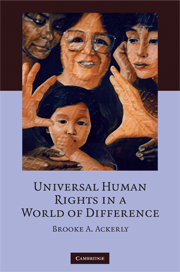Book contents
- Frontmatter
- Contents
- Acknowledgments
- 1 Universal human rights in a world of difference: challenging our thinking
- Part I Epistemology, diversity, and disagreement in theory and practice
- Part II A methodology for immanent theory
- Part III Immanent universal human rights: theory and practice
- 7 An immanent and universal theory of human rights
- 8 Terrain(s) of difficulty: obligation, problem-solving, and trust
- 9 Feminist strategies
- 10 “If I can make a circle”
- Bibliography
- Interviews
- Index
7 - An immanent and universal theory of human rights
Published online by Cambridge University Press: 06 July 2010
- Frontmatter
- Contents
- Acknowledgments
- 1 Universal human rights in a world of difference: challenging our thinking
- Part I Epistemology, diversity, and disagreement in theory and practice
- Part II A methodology for immanent theory
- Part III Immanent universal human rights: theory and practice
- 7 An immanent and universal theory of human rights
- 8 Terrain(s) of difficulty: obligation, problem-solving, and trust
- 9 Feminist strategies
- 10 “If I can make a circle”
- Bibliography
- Interviews
- Index
Summary
Preface
When I met Jean-Paul, he carried a map. He would introduce himself, “je viens d'un tout petit pays” (I come from a very small country), indicating its location on a map of the Great Lakes region of East Africa. The map included Tanzania, Burundi, Congo, Uganda, and Lake Kivu, Lake Victoria, Lake Tanganyika, and Lake Albert. In India, generally, the person he was meeting would have been better able to “locate” Rwanda in his imaginary if Jean-Paul's map had included the coast of Africa, the Indian Ocean, and India. At a transnational training session organized by a large development organization in India he was meeting people who were either Indian or had traveled to India. For most of them, the location of Rwanda was outside the bounds of their ability to picture Rwanda. Even after the genocide, most people lack the reference points needed to locate Rwanda geographically and in colonial and post-colonial geopolitics.
Jean-Paul carried a couple of family photos that also did not reveal much about what life was like for him in Rwanda, a country known until the genocide as a development success story, a success story that included increasing poverty and inequality. From the pictures, one understood the social norm for being photographed was to stand very still and look somber. By contrast, in his perpetual reference to friends, other farms, and increasing milk production “sur la colline” (on the hill), I came to imagine his life. In this hilly countryside, his hill was his neighborhood. The image of communities sharing life on a hill, an image evoked not by a map or pictures, constituted my imaginary Rwanda until the news of the genocide.
- Type
- Chapter
- Information
- Universal Human Rights in a World of Difference , pp. 197 - 231Publisher: Cambridge University PressPrint publication year: 2008



